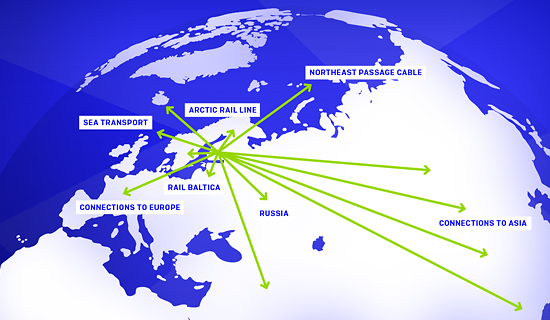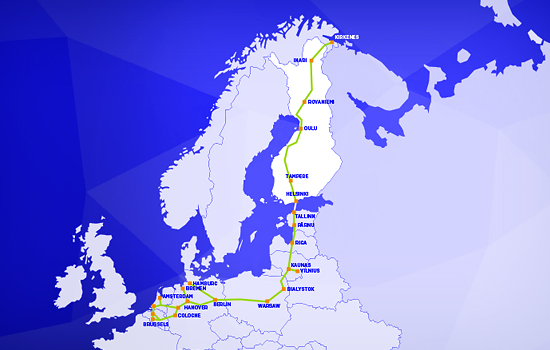ARCTIC STORIES According to the Finnish Minister of Transport and Communications Anne Berner, Finland’s Arctic transport projects are a part of a bigger picture that defines Finland’s position in the global environment.
In an interview for ArcticFinland, Berner comments on the background and future of the Northeast Passage telecommunications cable and the Arctic railway. She also brings up the possibilities of the EU transport network funding, responses to the Sámi people’s concerns and sheds light on her own ideas about the Arctic. She believes that the new global connections through Northern Finland will bring benefits to the entire society.
1. In your statements, you have emphasised Finland’s position in the Arctic. What, in short, is your vision of Finland’s Arctic role from the European and global perspective?
The importance of the Arctic Region is increasing worldwide and especially from the viewpoint of the Nordic Countries and the EU. Due to the melting of the ice sheets on the Arctic Ocean, the region is becoming more and more significant. The Arctic Region is important because of its tourism, extractive industries, future use of the Northeast Passage, oil and gas supplies, fishing industry and forest sector.
2. What does this mean for the transport infrastructure? What are the key requirements?
The key requirements for building a transport infrastructure are the Arctic railway and the Northeast Passage telecommunications cable project that will connect the growth centres of Europe and Asia. Both of these projects require cooperation with other countries.
3. What is the probability that the Northeast Passage telecommunications cable project will become reality, and in what timeframe? Does it require any more actions from the Finnish government?
The Northeast Passage telecommunications cable is one of the main projects of the current government term. The idea is to establish a project development company and the goal is to carry out the construction works on commercial terms from 2019 to 2022. The project company’s mission is to complete the financial, operational, technical and commercial preparations. Community relations are essential and play a big role in executing the project. The indicative budget for the project company is estimated at around 6 million euros. Cinia Group Oy has been mandated to start discussions and obtain funding for the project in different countries. In the design and development stages, Cinia and its foreign project partners are the main parties responsible for the funding of the project company. The company should be established in 2018.
4. What kind of effects could the cable have for Northern Finland?
The need for data transfer is estimated to increase tens of times by 2025. With the Northeast cable connection, it is possible to achieve the fastest physical telecommunications route between Asia and Northern and Central Europe via Norway, Russia and Finland. It would significantly decrease the delay in telecommunications between Europe and Asia. This, in turn, would have a substantial impact on the banks and stock exchange, for example, as well the advancement of the Internet of Things, 5G and robotisation. From the standpoint of Northern Finland, and Finland as a whole, the project promotes competitiveness, growth and employment, and increases the capacity of the communications networks.

Finland is an alternative corridor and hub for global flows of passengers, trade and data.
5. How important is it that the connections of Northern Finland can access the TEN-T network, what connections are they, and are there any risks on the road to success?
TEN-T is a dual layer transport network comprising a core network and a comprehensive network. The core network should be ready by the end of 2030 and the comprehensive network by the end of 2050. In addition, nine corridors for the core network that receive the majority of the EU funding have been mapped. A connection between Helsinki and Tornio was added to the Core Network Corridors in a regulation proposal that the Commission issued in the beginning of June. Currently, there are Core Network Corridors only in the Southernmost Finland. Due to the reform, EU funding for Finland’s transport projects could be multiplied. The hearing period for the proposed regulation is starting and it is likely to continue into Finland’s Presidency of the Council of the European Union in the latter half of 2019.
6. On a practical level: What does the access to the TEN-T network mean for Finland’s north–south connections? What will change?
Adding the Helsinki–Tornio corridor into the EU Core Network has to be seen as a part of a bigger picture: extending the EU’s transport network all the way to the ports in the Arctic Ocean. In 2023, the Commission is expected to start a review of the TEN-T guidelines. In that context, Finland can propose that the Arctic railway and the Tallinn tunnel will be added to the TEN-T network. On the other side of the Gulf of Finland, plans for the Rail Baltica railway from Tallinn to the central markets of the EU are being drafted. The railway is planned to be completed in 2026.
7. Is it possible that a concrete decision concerning the Arctic railway is made during this government term? What happens after the current working group phase?
Further investigation on the Arctic railway will continue in cooperation with Norway. A joint Task Force has begun to examine the next phases and schedules. It will also study the key questions around the chosen routing, such as environmental issues, impact on the indigenous peoples, permit procedures, costs, finance structure and finance model. The Task Force is to complete its work by 14 December 2018. In addition, the regional land use planning authorities in Northern Lapland continue examining the routing further.
Once the Task Force has completed its work, the situation will be re-evaluated.
8. There are no immediate economic justifications for the Arctic railway. What do You think is the best argument for building it? Do we have to consider connections from the points of view of Lapland, Finland, Europe or on the global scale?
The Arctic railway would improve the logistic position and accessibility of Finland and the connections in the entire Europe. It would serve as an alternative transport route for Finland’s exports and imports. Through the ice-free deep-water ports of the Arctic Ocean, a new connection would also open up to the Atlantic Ocean and the Northeast Passage.
The Arctic railway project should be considered especially with reference to the global connections and Finland’s global position.
9. Many Sámi authorities have expressed strong criticism towards the Arctic railway. What is Your response to their concerns?
The Kirkenes routing would affect, for example, the environment and economy as well as the livelihood, like reindeer husbandry, and culture of the Sámi people. However, the extent of the effects is yet to be evaluated. The Sámi Parliament and the Skolt Sámi village meeting are closely involved in the Task Force.
When planning the routing options, we have strived to take the invaluable nature sites of Northern Lapland into consideration. As the planning goes further, a more precise evaluation of the environmental effects needs to be made. In connection with the actual project, an environmental impact assessment (EIA) will also be carried out. More specific information will be compiled through field visits and inventories.
10. No former Minister of Transport and Communications has paid as much attention to the Arctic transport and logistics from Finland’s standpoint. What got You interested in the matter personally?
I see the Arctic connections as part of a larger whole that defines Finland’s position in the global environment.
Digitalisation and automation, climate change and urbanisation will transform all fields and industries. Our way of working, living and moving are in turmoil. The change is massive and goes through the entire society. Its consequences are impossible to fully predict, but I believe that it is wise to prepare for the future.
We need a vision to develop the infrastructure and a will to accomplish the goals of that vision. It should support the growth of Finland’s competitiveness and make our everyday lives easier. The vision would help in creating a framework for strategic decision-making and in supporting new investments in Finland. It would help businesses anticipate their future decisions and investments as well as provide support for the decision-makers in prioritisation. I believe that this will benefit the entire society.
Interview: Markku Heikkilä.
Photos (c) Tomi Parkkonen/Ministry of Transport and Communications
Maps (c) Ministry of Transport and Communications

The Arctic Railway together with Rail Baltica and the Tallinn tunnel would improve Finland's logistical position, accessibility and connections to Europe.